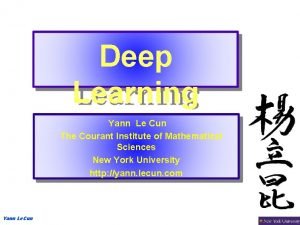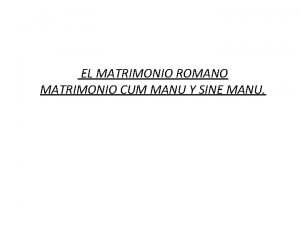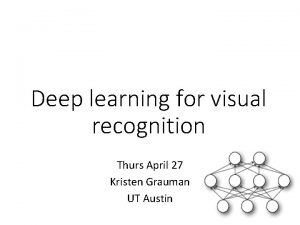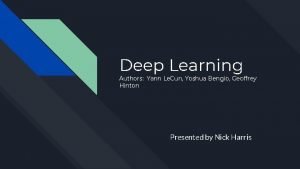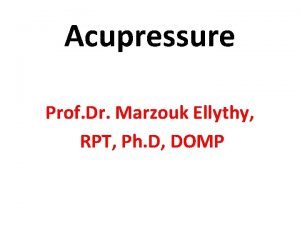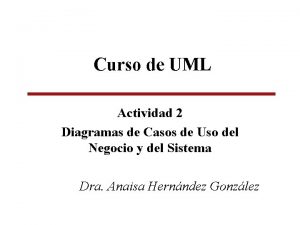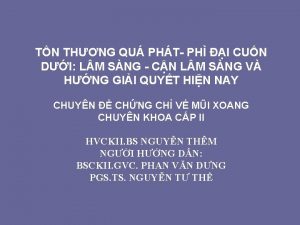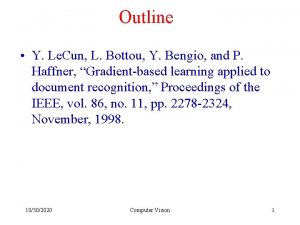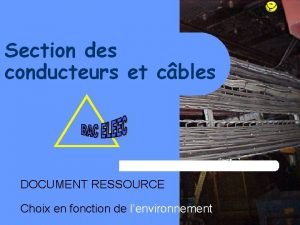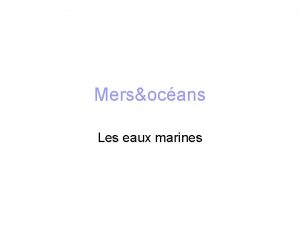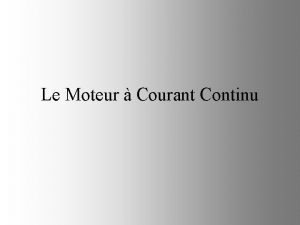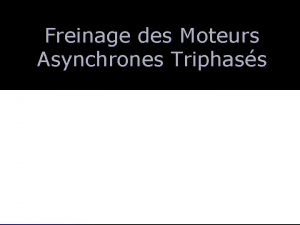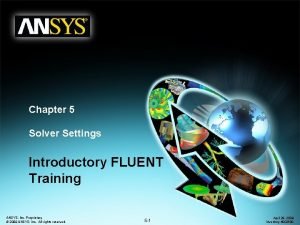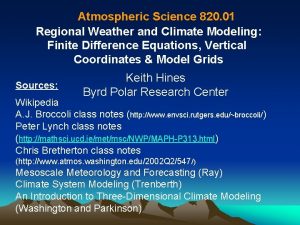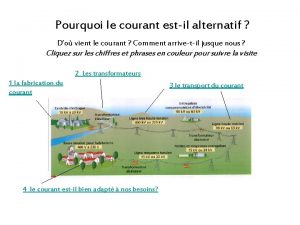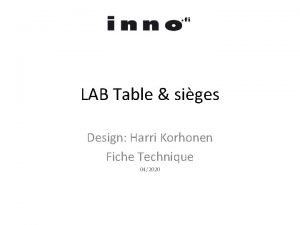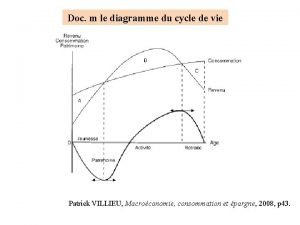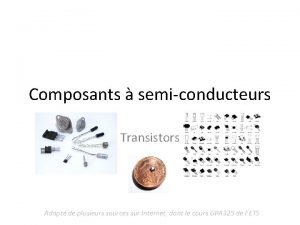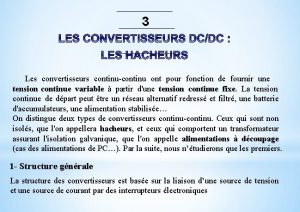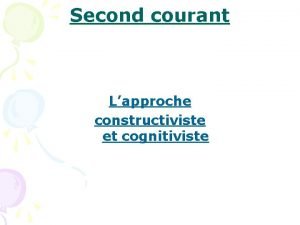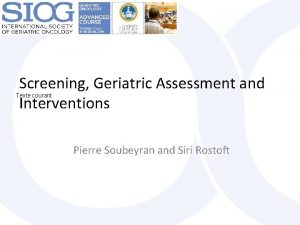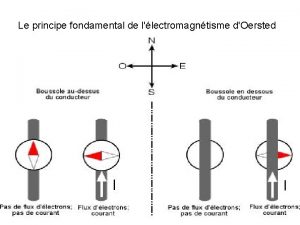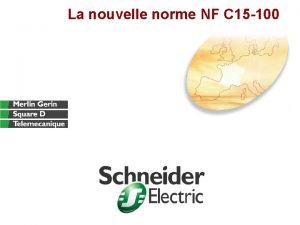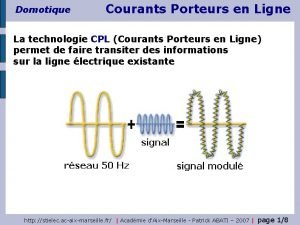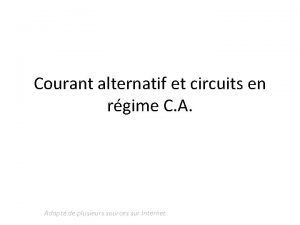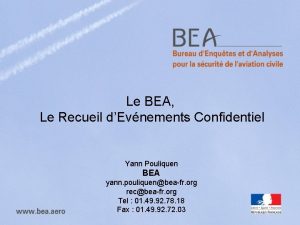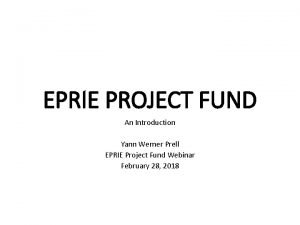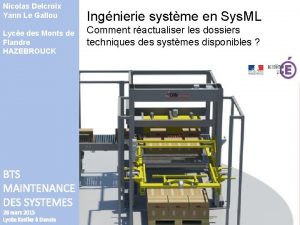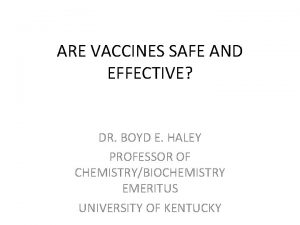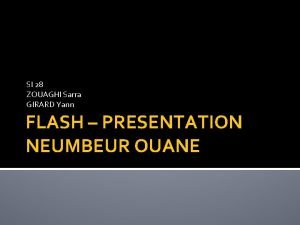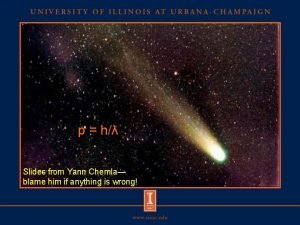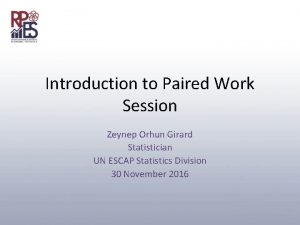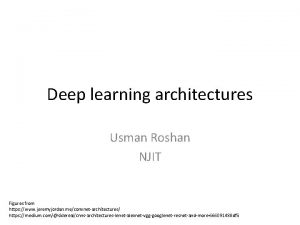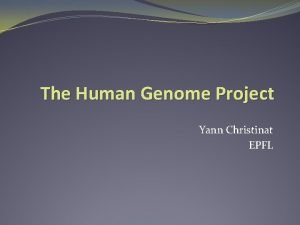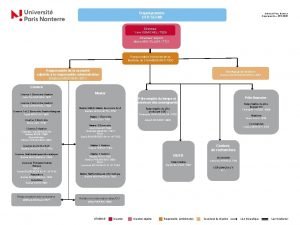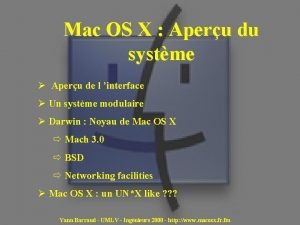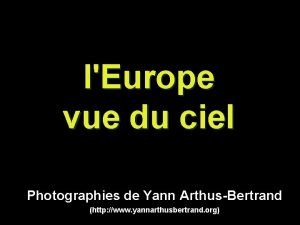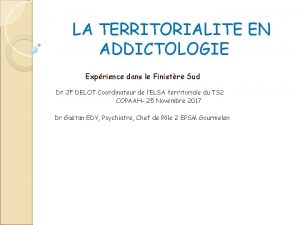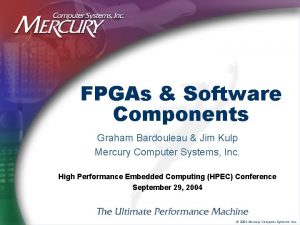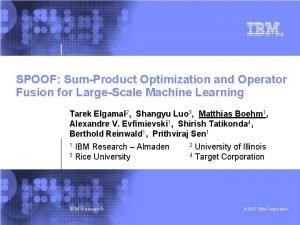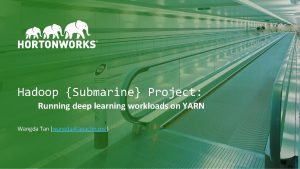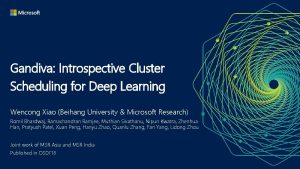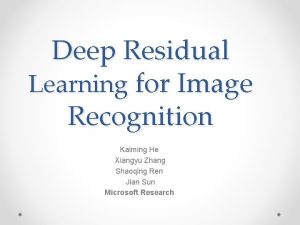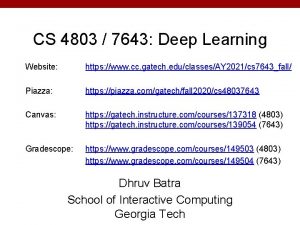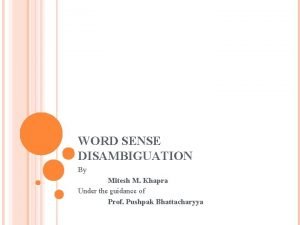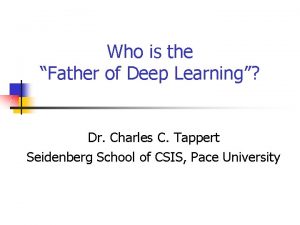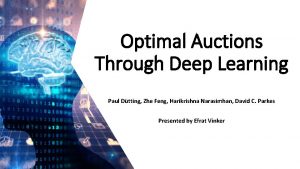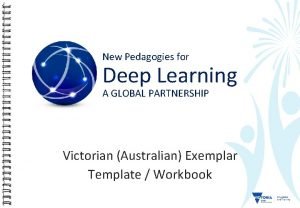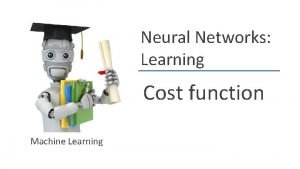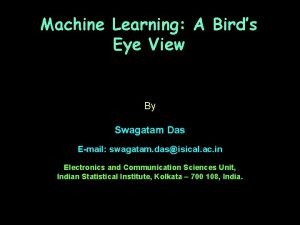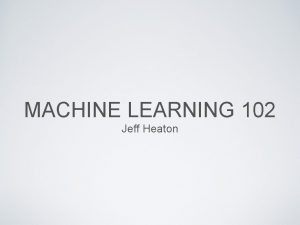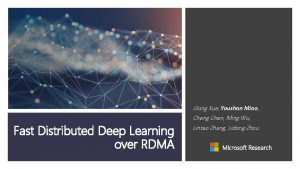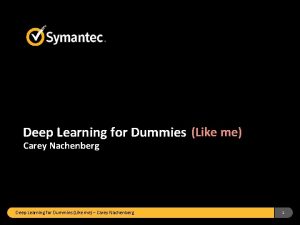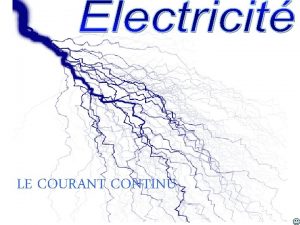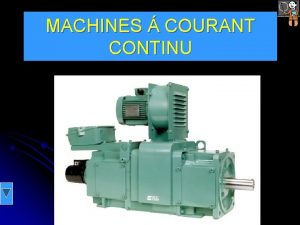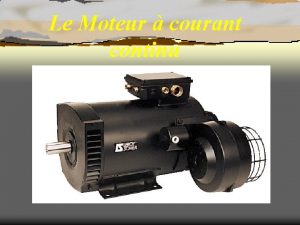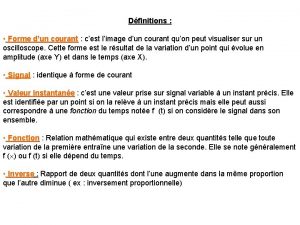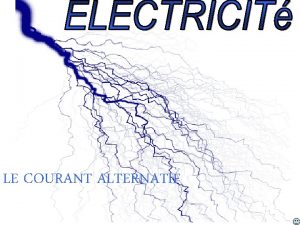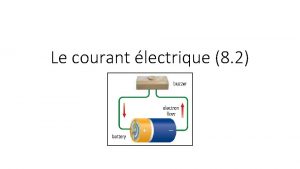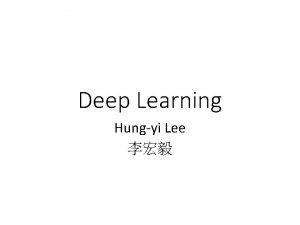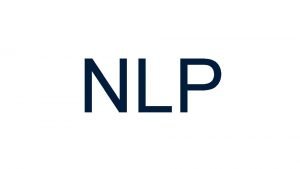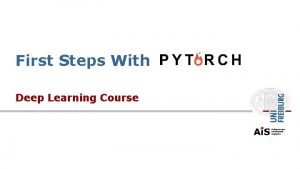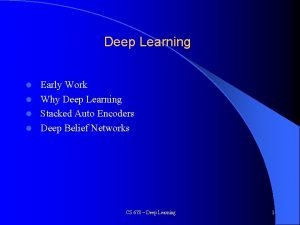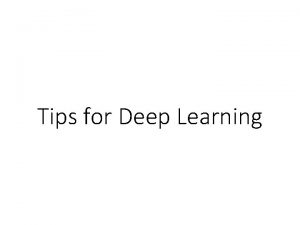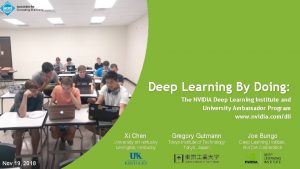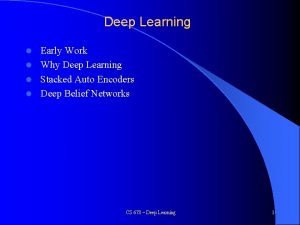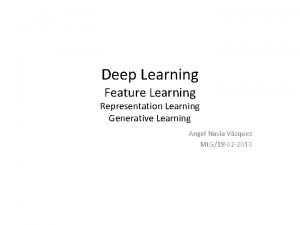Deep Learning Yann Le Cun The Courant Institute










![Strategies (a parody of [Hinton 2007]) Defeatism: since no good parameterization of the “AI-set” Strategies (a parody of [Hinton 2007]) Defeatism: since no good parameterization of the “AI-set”](https://slidetodoc.com/presentation_image_h/fe80b1f3d5d1e499938e82e9781136a7/image-11.jpg)


![An Old Idea for Local Shift Invariance [Hubel & Wiesel 1962]: simple cells detect An Old Idea for Local Shift Invariance [Hubel & Wiesel 1962]: simple cells detect](https://slidetodoc.com/presentation_image_h/fe80b1f3d5d1e499938e82e9781136a7/image-14.jpg)

































![Visual Navigation for a Mobile Robot [Le. Cun et al. NIPS 2005] Mobile robot Visual Navigation for a Mobile Robot [Le. Cun et al. NIPS 2005] Mobile robot](https://slidetodoc.com/presentation_image_h/fe80b1f3d5d1e499938e82e9781136a7/image-48.jpg)




















![Models Similar to Conv. Nets HMAX [Poggio & Riesenhuber 2003] [Serre et al. 2007] Models Similar to Conv. Nets HMAX [Poggio & Riesenhuber 2003] [Serre et al. 2007]](https://slidetodoc.com/presentation_image_h/fe80b1f3d5d1e499938e82e9781136a7/image-69.jpg)
- Slides: 69

Deep Learning Yann Le Cun The Courant Institute of Mathematical Sciences New York University http: //yann. lecun. com Yann Le. Cun

The Challenges of Machine Learning How can we use learning to progress towards AI? Can we find learning methods that scale? Can we find learning methods that solve really complex problems end-to-end, such as vision, natural language, speech. . ? How can we learn the structure of the world? How can we build/learn internal representations of the world that allow us to discover its hidden structure? How can we learn internal representations that capture the relevant information and eliminates irrelevant variabilities? How can a human or a machine learn internal representations by just looking at the world? Yann Le. Cun

The Next Frontier in Machine Learning: Learning Representations The big success of ML has been to learn classifiers from labeled data The representation of the input, and the metric to compare them are assumed to be “intelligently designed. ” Example: Support Vector Machines require a good input representation, and a good kernel function. The next frontier is to “learn the features” The question: how can a machine learn good internal representations In language, good representations are paramount. What makes the words “cat” and “dog” semantically similar? How can different sentences with the same meaning be mapped to the same internal representation? Yann Le. Cun How can we leverage unlabeled data (which is plentiful)?

The Traditional “Shallow” Architecture for Recognition Pre-processing / Feature Extraction this part is mostly handcrafted “Simple” Trainable Classifier Internal Representation The raw input is pre-processed through a hand-crafted feature extractor The features are not learned The trainable classifier is often generic (task independent), and “simple” (linear classifier, kernel machine, nearest neighbor, . . . ) The most common Machine Learning architecture: the Kernel Machine Yann Le. Cun

The Next Challenge of ML, Vision (and Neuroscience) How do we learn invariant representations? From the image of an airplane, how do we extract a representation that is invariant to pose, illumination, background, clutter, object instance. . How can a human (or a machine) learn those representations by just looking at the world? How can we learn visual categories from just a few examples? I don't need to see many airplanes before I can recognize every airplane (even really weird ones) Yann Le. Cun

Good Representations are Hierarchical Trainable Feature Extractor Trainable Classifier In Language: hierarchy in syntax and semantics Words->Parts of Speech->Sentences->Text Objects, Actions, Attributes. . . -> Phrases -> Statements -> Stories In Vision: part-whole hierarchy Pixels->Edges->Textons->Parts->Objects->Scenes Yann Le. Cun

“Deep” Learning: Learning Hierarchical Representations Trainable Feature Extractor Trainable Classifier Learned Internal Representation Deep Learning: learning a hierarchy of internal representations From low-level features to mid-level invariant representations, to object identities Representations are increasingly invariant as we go up the layers using multiple stages gets around the specificity/invariance dilemma Yann Le. Cun

The Primate's Visual System is Deep The recognition of everyday objects is a very fast process. The recognition of common objects is essentially “feed forward. ” But not all of vision is feed forward. Much of the visual system (all of it? ) is the result of learning How much prior structure is there? If the visual system is deep and learned, what is the learning algorithm? What learning algorithm can train neural nets as “deep” as the visual system (10 layers? ). Unsupervised vs Supervised learning What is the loss function? What is the organizing principle? Broader question (Hinton): what is the learning algorithm of the neo-cortex? Yann Le. Cun

Do we really need deep architectures? We can approximate any function as close as we want with shallow architecture. Why would we need deep ones? kernel machines and 2 -layer neural net are “universal”. Deep learning machines Deep machines are more efficient for representing certain classes of functions, particularly those involved in visual recognition they can represent more complex functions with less “hardware” We need an efficient parameterization of the class of functions that are useful for “AI” tasks. Yann Le. Cun

Why are Deep Architectures More Efficient? [Bengio & Le. Cun 2007 “Scaling Learning Algorithms Towards AAI”] deep architecture trades space for time (or breadth for depth) more layers (more sequential computation), but less hardware (less parallel computation). Depth-Breadth tradoff Example 1: N-bit parity requires N-1 XOR gates in a tree of depth log(N). requires an exponential number of gates of we restrict ourselves to 2 layers (DNF formula with exponential number of minterms). Example 2: circuit for addition of 2 N-bit binary numbers Requires O(N) gates, and O(N) layers using N one-bit adders with ripple carry propagation. Requires lots of gates (some polynomial in N) if we restrict ourselves to two layers (e. g. Disjunctive Normal Form). Bad news: almost all boolean functions have a DNF formula with an exponential number of minterms O(2^N). . . Yann Le. Cun
![Strategies a parody of Hinton 2007 Defeatism since no good parameterization of the AIset Strategies (a parody of [Hinton 2007]) Defeatism: since no good parameterization of the “AI-set”](https://slidetodoc.com/presentation_image_h/fe80b1f3d5d1e499938e82e9781136a7/image-11.jpg)
Strategies (a parody of [Hinton 2007]) Defeatism: since no good parameterization of the “AI-set” is available, let's parameterize a much smaller set for each specific task through careful engineering (preprocessing, kernel. . ). Denial: kernel machines can approximate anything we want, and the VC-bounds guarantee generalization. Why would we need anything else? unfortunately, kernel machines with common kernels can only represent a tiny subset of functions efficiently Optimism: Let's look for learning models that can be applied to the largest possible subset of the AI-set, while requiring the smallest amount of task-specific knowledge for each task. There is a parameterization of the AI-set with neurons. Is there an efficient parameterization of the AI-set with computer technology? Today, the ML community oscillates between defeatism and denial. Yann Le. Cun

Supervised Deep Learning, The Convolutional Network Architecture Convolutional Networks: [Le. Cun et al. , Neural Computation, 1988] [Le. Cun et al. , Proc IEEE 1998] (handwriting recognition) Face Detection and pose estimation with convolutional networks: [Vaillant, Monrocq, Le. Cun, IEE Proc Vision, Image and Signal Processing, 1994] [Osadchy, Miller, Le. Cun, JMLR vol 8, May 2007] Category-level object recognition with invariance to pose and lighting [Le. Cun, Huang, Bottou, CVPR 2004] [Huang, Le. Cun, CVPR 2006] autonomous robot driving Yann Le. Cun [Le. Cun et al. NIPS 2005]

Deep Supervised Learning is Hard The loss surface is non-convex, ill-conditioned, has saddle points, has flat spots. . . For large networks, it will be horrible! (not really, actually) Back-prop doesn't work well with networks that are tall and skinny. Lots of layers with few hidden units. Back-prop works fine with short and fat networks But over-parameterization becomes a problem without regularization Short and fat nets with fixed first layers aren't very different from SVMs. For reasons that are not well understood theoretically, backprop works well when they are highly structured e. g. convolutional networks. Yann Le. Cun
![An Old Idea for Local Shift Invariance Hubel Wiesel 1962 simple cells detect An Old Idea for Local Shift Invariance [Hubel & Wiesel 1962]: simple cells detect](https://slidetodoc.com/presentation_image_h/fe80b1f3d5d1e499938e82e9781136a7/image-14.jpg)
An Old Idea for Local Shift Invariance [Hubel & Wiesel 1962]: simple cells detect local features complex cells “pool” the outputs of simple cells within a retinotopic neighborhood. “Simple cells” “Complex cells” Multiple convolutions pooling subsampling Retinotopic Feature Maps Yann Le. Cun

The Multistage Hubel-Wiesel Architecture Building a complete artificial vision system: Stack multiple stages of simple cells / complex cells layers Higher stages compute more global, more invariant features Stick a classification layer on top [Fukushima 1971 -1982] neocognitron [Le. Cun 1988 -2007] convolutional net [Poggio 2002 -2006] HMAX [Ullman 2002 -2006] fragment hierarchy [Lowe 2006] HMAX QUESTION: How do we find (or learn) the filters? Yann Le. Cun

Getting Inspiration from Biology: Convolutional Network Hierarchical/multilayer: features get progressively more global, invariant, and numerous dense features: features detectors applied everywhere (no interest point) broadly tuned (possibly invariant) features: sigmoid units are on half the time. Global discriminative training: The whole system is trained “end-to-end” with a gradient -based method to minimize a global loss function Integrates segmentation, feature extraction, and invariant classification in one fell swoop. Yann Le. Cun

Convolutional Net Architecture input 1@32 x 32 Layer 1 Layer 2 6@28 x 28 6@14 x 14 Layer 3 12@10 x 10 Layer 4 Layer 5 100@1 x 12@5 x 5 1 Layer 6: 10 1 0 5 x 5 convolution 5 x 5 2 x 2 pooling/ convolution pooling/ subsampling convolution subsampling Convolutional net for handwriting recognition (400, 000 synapses) Convolutional layers (simple cells): all units in a feature plane share the same weights Pooling/subsampling layers (complex cells): for invariance to small distortions. Supervised gradient-descent learning using back-propagation The entire network is trained end-to-end. All the layers are trained simultaneously. Yann Le. Cun

Back-propagation: deep supervised gradient-based learning Yann Le. Cun

Any Architecture works Any connection is permissible Networks with loops must be “unfolded in time”. Any module is permissible As long as it is continuous and differentiable almost everywhere with respect to the parameters, and with respect to non-terminal inputs. Yann Le. Cun

Deep Supervised Learning is Hard Example: what is the loss function for the simplest 2 -layer neural net ever Function: 1 -1 -1 neural net. Map 0. 5 to 0. 5 and -0. 5 to -0. 5 (identity function) with quadratic cost: Yann Le. Cun

MNIST Handwritten Digit Dataset MNIST: 60, 000 training samples, 10, 000 test samples Yann Le. Cun

Results on MNIST Handwritten Digits Yann Le. Cun

Some Results on MNIST (from raw images: no preprocessing) Note: some groups have obtained good results with various amounts of preprocessing such as deskewing (e. g. 0. 56% using an SVM with smart kernels [de. Coste and Schoelkopf]) hand-designed feature representations (e. g. 0. 63% with “shape context” and nearest neighbor [Belongie] Yann Le. Cun

Invariance and Robustness to Noise Yann Le. Cun

Handwriting Recognition Yann Le. Cun

Face Detection and Pose Estimation with Convolutional Nets Training: 52, 850, 32 x 32 grey-level images of faces, 52, 850 non-faces. Each sample: used 5 times with random variation in scale, in-plane rotation, brightness and contrast. 2 nd phase: half of the initial negative set was replaced by false positives of the initial version of the detector. Yann Le. Cun

Face Detection: Results Yann Le. Cun

Face Detection and Pose Estimation: Results Yann Le. Cun

Face Detection with a Convolutional Net Yann Le. Cun

Generic Object Detection and Recognition with Invariance to Pose and Illumination 50 toys belonging to 5 categories: animal, human figure, airplane, truck, car 10 instance per category: 5 instances used for training, 5 instances for testing Raw dataset: 972 stereo pair of each object instance. 48, 600 image pairs total. For each instance: 18 azimuths 0 to 350 degrees every 20 degrees 9 elevations 30 to 70 degrees from horizontal every 5 degrees 6 illuminations on/off combinations of 4 lights 2 cameras (stereo) 7. 5 cm apart 40 cm from the object Yann Le. Cun Training instances Test instances

Textured and Cluttered Datasets Yann Le. Cun

Experiment 1: Normalized-Uniform Set: Representations 1 - Raw Stereo Input: 2 images 96 x 96 pixels input dim. = 18432 2 - Raw Monocular Input: 1 image, 96 x 96 pixels input dim. = 9216 3 – Subsampled Mono Input: 1 image, 32 x 32 pixels input dim = 1024 4 – PCA-95 (Eigen. Toys): First 95 Principal Components input dim. = 95 First 60 eigenvectors (Eigen. Toys) Yann Le. Cun

Convolutional Network Layer 3 Stereo Layer 1 input 8@92 x 92 2@96 x 96 5 x 5 convolution (16 kernels) 24@18 x 18 Layer 4 24@6 x 6 Layer 2 8@23 x 23 4 x 4 Layer 6 Layer 5 Fully 100 (500 weights) 5 6 x 6 subsampling convolution (96 kernels) 3 x 3 connected 6 x 6 convolution subsampling (2400 kernels) 90, 857 free parameters, 3, 901, 162 connections. The architecture alternates convolutional layers (feature detectors) and subsampling layers (local feature pooling for invariance to small distortions). The entire network is trained end-to-end (all the layers are trained simultaneously). A gradient-based algorithm is used to minimize a supervised loss function. Yann Le. Cun

Normalized-Uniform Set: Error Rates Linear Classifier on raw stereo images: error. K-Nearest-Neighbors on raw stereo images: K-Nearest-Neighbors on PCA-95: 16. 6% error. Pairwise SVM on 96 x 96 stereo images: error Pairwise SVM on 95 Principal Components: Convolutional Net on 96 x 96 stereo images: Yann Le. Cun Training Test 30. 2% 18. 4% error. 11. 6% 13. 3% error. 5. 8% error.

Normalized-Uniform Set: Learning Times SVM: using a parallel implementation by Graf, Durdanovic, and Cosatto (NEC Labs) Yann Le. Cun Chop off the last layer of the convolutional net and train an SVM on it

Jittered-Cluttered Dataset: 291, 600 tereo pairs for training, 58, 320 for testing Objects are jittered: position, scale, in-plane rotation, contrast, brightness, backgrounds, distractor objects, . . . Input dimension: 98 x 2 (approx 18, 000) Yann Le. Cun

Experiment 2: Jittered-Cluttered Dataset 291, 600 training samples, 58, 320 test samples SVM with Gaussian kernel 43. 3% error Convolutional Net with binocular input: error Convolutional Net + SVM on top: 5. 9% error Convolutional Net with monocular input: 20. 8% error Yann Le. Cun 7. 8%

Jittered-Cluttered Dataset OUCH! Yann Le. Cun The convex loss, VC bounds and representers theorems Chop off the last layer, and train an SVM on it

What's wrong with K-NN and SVMs? K-NN and SVM with Gaussian kernels are based on matching global templates Both are “shallow” architectures There is now way to learn invariant recognition tasks with such naïve architectures (unless we use an impractically large number of templates). Output The number of necessary templates grows exponentially with the number of Linear dimensions of variations. Combination Global templates are in trouble when the s variations include: category, instance Features (similarities) shape, configuration (for articulated object), position, azimuth, elevation, scale, Global Template Matchers illumination, texture, albedo, in-plane rotation, background luminance, (each training sample is a background texture, background clutter, . . . template Input

Examples (Monocular Mode) Yann Le. Cun

Learned Features Layer 3 Layer 1 Input Yann Le. Cun

Examples (Monocular Mode) Yann Le. Cun

Examples (Monocular Mode) Yann Le. Cun

Examples (Monocular Mode) Yann Le. Cun

Examples (Monocular Mode) Yann Le. Cun

Examples (Monocular Mode) Yann Le. Cun

Examples (Monocular Mode) Yann Le. Cun
![Visual Navigation for a Mobile Robot Le Cun et al NIPS 2005 Mobile robot Visual Navigation for a Mobile Robot [Le. Cun et al. NIPS 2005] Mobile robot](https://slidetodoc.com/presentation_image_h/fe80b1f3d5d1e499938e82e9781136a7/image-48.jpg)
Visual Navigation for a Mobile Robot [Le. Cun et al. NIPS 2005] Mobile robot with two cameras The convolutional net is trained to emulate a human driver from recorded sequences of video + human-provided steering angles. The network maps stereo images to steering angles for obstacle avoidance

Convolutional Nets for Counting/Classifying Zebra Fish Head – Straight Tail – Curved Tail Yann Le. Cun

C. Elegans Embryo Phenotyping Analyzing results for Gene Knock-Out Experiments

C. Elegans Embryo Phenotyping Analyzing results for Gene Knock-Out Experiments

C. Elegans Embryo Phenotyping Analyzing results for Gene Knock-Out Experiments

Convolutional Nets For Brain Imaging and Biology Brain tissue reconstruction from slice images [Jain, . . , Denk, Seung 2007] Sebastian Seung's lab at MIT. 3 D convolutional net for image segmentation Conv. Nets Outperform MRF, Conditional Random Fields, Mean Shift, Diffusion, . . . [ICCV'07] Yann Le. Cun

Convolutional Nets for Image Region Labeling Long-range obstacle labeling for vision-based mobile robot navigation (more on this later. . ) Yann Le. Cun Input image Stereo Labels Classifier Output

Input image Stereo Labels Classifier Output Page 62

Industrial Applications of Conv. Nets AT&T/Lucent/NCR Check reading, OCR, handwriting recognition (deployed 1996) Vidient Inc's “Smart. Catch” system deployed in several airports and facilities around the US for detecting intrusions, tailgating, and abandoned objects (Vidient is a spin-off of NEC) NEC Labs Cancer cell detection, automotive applications, kiosks Google OCR, ? ? ? Microsoft OCR, handwriting recognition, speech detection France Telecom Face detection, HCI, cell phone-based applications Other projects: HRL (3 D vision). . Yann Le. Cun

CNP: FPGA Implementation of Conv. Nets Implementation on low-end Xilinx FPGA Xilinx Spartan 3 A-DSP: 250 MHz, 126 multipliers. Face detector Conv. Net at 640 x 480: 5 e 8 connections 8 fps with 200 MHz clock: 4 Gcps effective Prototype runs at lower speed b/c of narrow memory bus on dev board Very lightweight, very low power Custom board the size of a matchbox (4 chips: FPGA + 3 RAM chips) good for micro UAVs vision-based navigation. High-End FPGA could deliver very high speed: 1024 multipliers at 500 MHz: 500 Gcps peak perf. Yann Le. Cun

CNP Architecture Yann Le. Cun

Systolic Convolver: 7 x 7 kernel in 1 clock cycle Yann Le. Cun

Design Soft CPU used as micro-sequencer Micro-program is a C program on soft CPU 16 x 16 fixed-point multipliers Weights on 16 bits, neuron states on 8 bits. Instruction set includes: Convolve X with kernel K result in Y, with sub-sampling ratio S Sigmoid X to Y Multiply/Divide X by Y (for contrast normalization) Microcode generated automatically from network description in Lush Yann Le. Cun

Face detector on CNP Yann Le. Cun

Results Clock speed limited by low memory bandwidth on the development board Dev board uses a single DDR with 32 bit bus Custom board will use 128 bit memory bus Currently uses a single 7 x 7 convolver We have space for 2, but the memory bandwidth limits us Current Implementation: 5 fps at 512 x 384 Custom board will yield 30 fps at 640 x 480 4 e 10 connections per second peak. Yann Le. Cun

Results Yann Le. Cun

Results Yann Le. Cun

Results Yann Le. Cun

Results Yann Le. Cun

Results Yann Le. Cun

FPGA Custom Board: NYU Conv. Net Proc Xilinx Virtex 4 FPGA, 8 x 5 cm board Dual camera port, expansion and I/O port Dual QDR RAM for fast memory bandwidth Micro. SD port for easy configuration DVI output Serial communication to optional host Yann Le. Cun
![Models Similar to Conv Nets HMAX Poggio Riesenhuber 2003 Serre et al 2007 Models Similar to Conv. Nets HMAX [Poggio & Riesenhuber 2003] [Serre et al. 2007]](https://slidetodoc.com/presentation_image_h/fe80b1f3d5d1e499938e82e9781136a7/image-69.jpg)
Models Similar to Conv. Nets HMAX [Poggio & Riesenhuber 2003] [Serre et al. 2007] [Mutch and Lowe CVPR 2006] Difference? the features are not learned HMAX is very similar to Fukushima's Neocognitron Yann Le. Cun [from Serre et al. 2007]
 Cun
Cun Cmu machine learning
Cmu machine learning Tony wagner's seven survival skills
Tony wagner's seven survival skills Usus matrimonio romano
Usus matrimonio romano Le cun
Le cun Le cun
Le cun Le cun
Le cun Cun measurements tcm
Cun measurements tcm Extend casos de uso
Extend casos de uso Gương glatzel
Gương glatzel Cun l
Cun l Calcul du courant admissible iz
Calcul du courant admissible iz Convalutes
Convalutes La loi de la place
La loi de la place A quel courant artistique appartient claude monet
A quel courant artistique appartient claude monet Freinage hypersynchrone
Freinage hypersynchrone Courant number in ansys fluent
Courant number in ansys fluent Courant number
Courant number Un courant alternatif
Un courant alternatif Korhonen courant
Korhonen courant Les types de hacheur
Les types de hacheur Revenu courant
Revenu courant Source de courant commandée en tension
Source de courant commandée en tension Tension moyenne
Tension moyenne Il nous tient au courant
Il nous tient au courant Courant cognitiviste
Courant cognitiviste Texte courant
Texte courant Intensité du courant
Intensité du courant Norme prise de courant
Norme prise de courant Domotique courant porteur
Domotique courant porteur Amplitude courant alternatif
Amplitude courant alternatif Deep asleep deep asleep it lies
Deep asleep deep asleep it lies Deep forest towards an alternative to deep neural networks
Deep forest towards an alternative to deep neural networks 深哉深哉
深哉深哉 Yann pouliquen
Yann pouliquen Yann werner
Yann werner école yann arthus bertrand cysoing
école yann arthus bertrand cysoing Yann kulp
Yann kulp Retranscriptible
Retranscriptible Dr raymond obomsawin
Dr raymond obomsawin Amel zouaghi
Amel zouaghi Yann le testu
Yann le testu Yann chemla
Yann chemla Yann zouaghi
Yann zouaghi Usman roshan njit
Usman roshan njit Yann christinat
Yann christinat Ufr segmi
Ufr segmi Aperu
Aperu Ecole yann arthus bertrand
Ecole yann arthus bertrand Ty yann brest addictologie
Ty yann brest addictologie Yann kulp
Yann kulp Cuadro comparativo de e-learning
Cuadro comparativo de e-learning Operator fusion deep learning
Operator fusion deep learning Rnn andrew ng
Rnn andrew ng Hortonworks gpu
Hortonworks gpu Gandiva: introspective cluster scheduling for deep learning
Gandiva: introspective cluster scheduling for deep learning Kaiming he
Kaiming he Deep learning speech recognition
Deep learning speech recognition Cs 7643 fall 2020
Cs 7643 fall 2020 Autoencoders, unsupervised learning, and deep architectures
Autoencoders, unsupervised learning, and deep architectures Wsbgixdc9g8 -site:youtube.com
Wsbgixdc9g8 -site:youtube.com Mitesh kapra
Mitesh kapra Father of deep learning
Father of deep learning Dtting
Dtting Deep learning competencies 6 c's
Deep learning competencies 6 c's Cost function deep learning
Cost function deep learning Bird eye view deep learning
Bird eye view deep learning Jeff heaton github
Jeff heaton github Jilong xue
Jilong xue Deep learning dummies
Deep learning dummies
